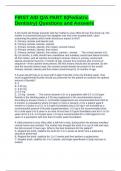FIRST AID Q/A PART II(Pediatric
Dentistry) Questions and Answers
A 20-month-old female presents with her mother to your office for her first check-up. Her
mother is concerned because her daughter only has a few erupted teeth. Upon
examining the patient,which teeth should you expect to find?
A. Primary centrals and laterals only
B. Primary centrals, laterals, canines
C. Primary centrals, laterals, first molars, second molars
D. Primary centrals, laterals, first molars
E. Primary centrals, laterals, first molars, canines - answer The correct answer is E.
By 19 months, a child should have mandibular and maxillary central and lateral incisors,
all first molars, and all canines.According to answer choice A, primary central and
laterals should be found by 7 months of age. Answer B is incorrect also in terms of
sequence—if the canines were present, the first molars should also be present. By the
time the second molars erupt, the canines should already be present in the mouth.
Primary centrals, laterals,and first molars should erupt by 15 months of age.
A 5-year-old girl lives in an area with 0.4ppm Fluoride in the city drinking water. How
much supplemental fluoride should you prescribe for the patient to consume the optimal
amount of fluoride?
A. 0
B. 0.25 mg
C. 0.33 mg
D. 0.5 mg
E. 1.0 mg - answer The correct answer is B. In a population with 0.3- to 0.6-ppm
fluoride in the drinking water,a 0.25-mg supplement is the recommended amount.
According to answer choice A, no fluoride supplements are recommended from birth to
6 months, in populations where 0.6 ppm or more is present, or for a patient aged 6
months to 3 years in a 0.3- to 0.6-ppm fluoridated area.0.33 mg is not included as a
recommended amount of fluoride supplementation. 0.5 mg is the recommended dose
for a child aged 3 to 6 years in an area of less than 0.3-ppm fluoridation,and for 6- to 16-
years old in a 0.3- to 0.6-ppm area. 1.0 mg is recommended for a child aged 6 to 16
years in a population with less than 0.3-ppm water fluoridation
A child presents to your office after a fall from a tree, during which his primary maxillary
central incisor was avulsed. The mother has brought the tooth in a cup of milk and says
the fall occurred 2 hours ago. What is the best treatment for this patient?
A. Replant the tooth, stabilize the tooth for 1 to 2 weeks at which time a pulpotomy
should be performed
B. Replant the tooth, stabilize for 1 to 2 weeks,and then perform a pulpectomy
C. Replant tooth, stabilize for 1 to 2 weeks, and begin apexification if pulp necrosis is
evident
, D. Take a radiograph, irrigate socket, do not replant tooth - answer The correct
answer is D. A primary tooth has a poor prognosis if replantation is attempted;therefore,
primary teeth are very rarely replanted.A radiograph should be taken to visualize if any
fragments of the tooth remain. If the tooth was a permanent tooth, the tooth may be
replanted, splinted, and then root canal therapy(RCT) performed after 7 to 10 days. If
the apices of the tooth are open, the tooth should be
monitored and apexification procedures should begin if there is evidence of an infected
pulp.As explained before, if the tooth was permanent with closed apices, the steps
indicated in answer choice B should be followed. This answer choice is the best
treatment if a permanent tooth was avulsed that had open apices and evidence of an
infected pulp.
A 6-year-old child presents with a Class I fracture to a tooth with an immature apex.
What is the treatment of choice for this patient?
A. Restore tooth
B. Place calcium hydroxide to exposed dentin, restore tooth
C. Perform pulpotomy, then temporarily restore
D. Perform pulpectomy, place stainless steel crown
E. Extract tooth, place space maintainer - answer The correct answer is A. Class I
fracture involves only the enamel of the tooth. Smoothing out the rough edges of the
enamel and restoring with a permanent restoration is the only treatment necessary for
this tooth. In Class II fracture, this may be covered with calcium hydroxide or glass
ionomer and restored as there will be much more substantial dentin exposure. No
pulpotomy is necessary since there was no pulp exposure (as in a Class III fracture)
and the pulp is still vital. As in answer choice C, the pulp is still healthy,so a pulpectomy
is not necessary. An stainless steel crown (SSC) is also not necessary if only a minimal
amount of enamel has been lost. In Class IV fracture, a pulpectomy and an SSC are
both necessary as the entire crown has been lost.
There is no indication for extraction of a tooth
that has a healthy pulp, no fracture present, and
may be restored with a permanent restorative
material.
A disease process is characterized by painful, bleeding gingival tissue, punched out
erosions covered by gray pseudomembrane, blunting of interproximal papillae, and a
fetid odor. Treatment usually comprises debridement, mouth rinses, and antibiotics.
This description is associated with which of the following conditions that may exist in
teenagers?
A. Aggressive periodontitis
B. Acute necrotizing ulcerative gingivitis
C. Primary herpetic gingivostomatitis
D. Severe gingivitis
E. Early childhood caries - answer The correct answer is B. Acute necrotizing
ulcerative gingivitis may occur in both adults and teenagers and is also known as
Vincent's infection,Vincent's angina, or trench mouth. This is a painful condition that
reacts well to debridement, hydrogen peroxide rinses, and antibiotics and is caused by




